How To Clean Baby's Nose When Sick
15 Spring Cleaning Mistakes That Could Make You Sick
You think you're doing a good job of getting your house sparkling, but could you actually be harming your health in the process?
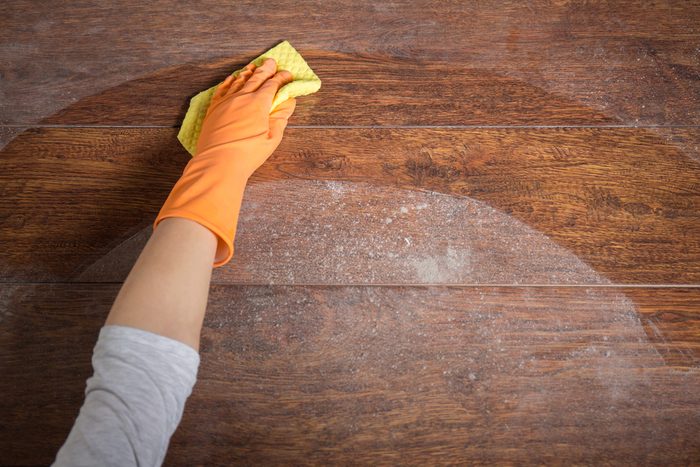 Photographee.eu/Shutterstock
Photographee.eu/Shutterstock
You're stirring up dust
Anyone who's ever cleaned a dusty bookcase or a neglected spare room knows dust makes you sneeze. "Dust is a common trigger for asthma and allergy symptoms," says Jennifer Caudle, DO, a family physician and associate professor at Rowan University School of Osteopathic Medicine. But did you know dust can actually be toxic? A meta-analysis from George Washington University found unhealthy levels of chemicals in dust that can cause everything from hormone disruptions to asthma to even cancer.
To avoid ingesting or breathing dust as much as possible, wipe up dust frequently—don't just save hard-to-reach spots for spring cleaning—and follow a "top-down" strategy. "Start with ceilings and high shelving, and work your way to the floors to limit redistribution of dust and other particles to freshly cleaned surfaces," says Samara Geller, a senior research and database analyst at Environmental Working Group (EWG). In addition, "look for a vacuum equipped with a HEPA filter to more effectively trap dust, allergens, and contaminants," she says.
ⓘ
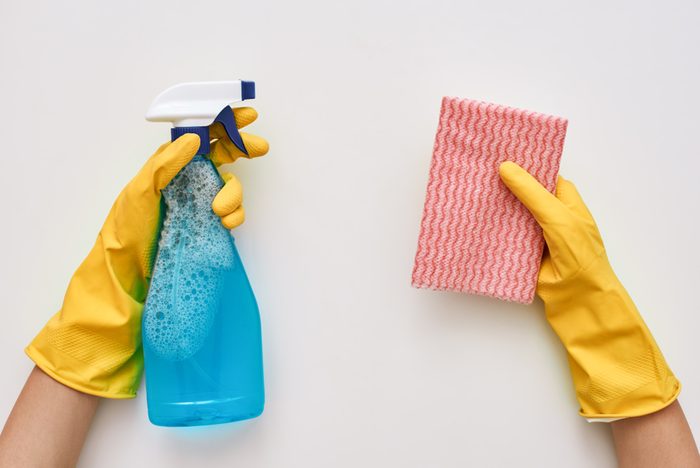 Dima Sidelnikov/Shutterstock
Dima Sidelnikov/Shutterstock
You're using fragranced cleaners
Your cleaner may smell like lemons or flowers, but unfortunately, that may be linked to health problem. "In my national population studies, I found over one-third of Americans report adverse health effects from fragranced consumer products, such as air fresheners, deodorizers, laundry detergents, dryer sheets, hand sanitizers, essential oils, scented candles, disinfectant sprays, dish-washing detergents, and other types of scented products,"Anne Steinemann, PhD, a professor of civil engineering at the University of Melbourne in Australia says "Common health problems from exposure to fragranced cleaning products include migraines, asthma attacks, breathing difficulties, dizziness, seizures, nausea, watery eyes, and skin rashes."
Dr. Caudle also warns that strong smells from cleaners can trigger headaches. Instead, opt for products labeled "fragrance-free"—not "unscented," as those may include a masking fragrance, Steinemann says.
 Marko Aliaksandr/Shutterstock
Marko Aliaksandr/Shutterstock
You're using harsh cleaners
The products you choose may also be too abrasive for your needs. "Some cleanings products are caustic, meaning they have a very high or very low pH," says U.S. Consumer Product Safety Commission (USCPSC) spokesperson Nychelle Fleming. "This can lead to caustic burns to the skin, eyes, or internally if swallowed." In addition to being a poisoning risk, even cleaning with them can be harmful. "As a family doctor, I've seen patients get skin irritation from contact with cleansers or other chemicals," Dr. Caudle says.
Avoid products that use the ingredients sulfuric acid and sodium hydroxide, says Geller. "Certain categories of cleaners tend to be more acutely hazardous, such as heavy-duty degreasers and general purpose solvents, drain cleaners, toilet bowl cleaners, and oven cleaners," she says. In general, use the gentlest product that can get the job done.
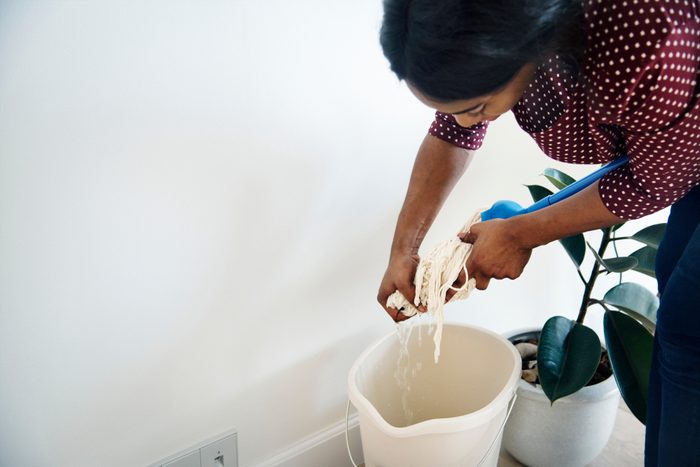 Rawpixel.com/Shutterstock
Rawpixel.com/Shutterstock
You mix bleach and ammonia
The golden rule of cleaning (and poison prevention): Never mix cleaners with chlorine bleach and those with ammonia together. "Mixing bleach and ammonia can lead to the formation of chloramine vapor, which is toxic if inhaled," says Fleming. Cleaning expert Melissa Maker, founder of Canadian cleaning service Clean My Space and host of the CleanMySpace YouTube Channel, advises using oxygen bleach as a non-toxic option when a job calls for disinfecting. "I don't like chlorine bleach in my home, which is why I recommend oxygen bleach," she says.
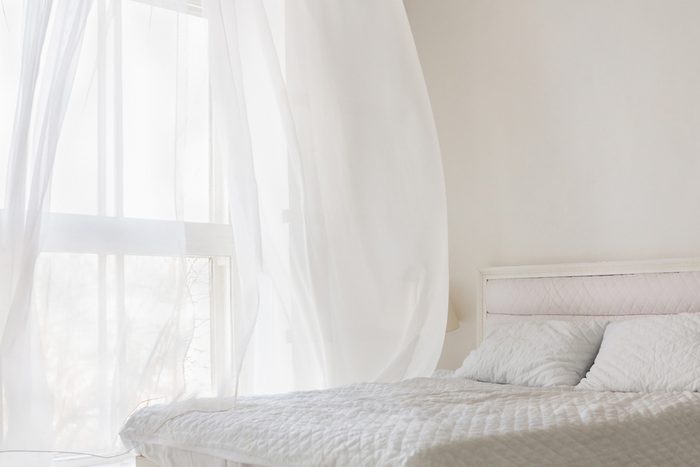 Dmitry Zimin/Shutterstock
Dmitry Zimin/Shutterstock
You're not airing out enough
Because studies have shown cleaning is linked to exposures that cause a decline in lung function, reduce toxic particles and fumes by circulating the air in your house during the task. "Keep the inside of your home well-ventilated while cleaning and dusting," Geller says. "Open windows—and even doors—and run the central air system or an exhaust fan." This goes for cleaning in general, not just when you're dusting. In addition, try bringing your cleaning into the outdoors. "Airing things out outside is fantastic: Sunlight, or UV rays, act as an antibacterial so it can help kill bacteria," says Maker. For example, air out winter blankets on a clothesline to help get rid of dust mites, and shake out throw rugs to rid them of dust—vacuuming them can be difficult. Here are the 13 best cleaning products for people with allergies.
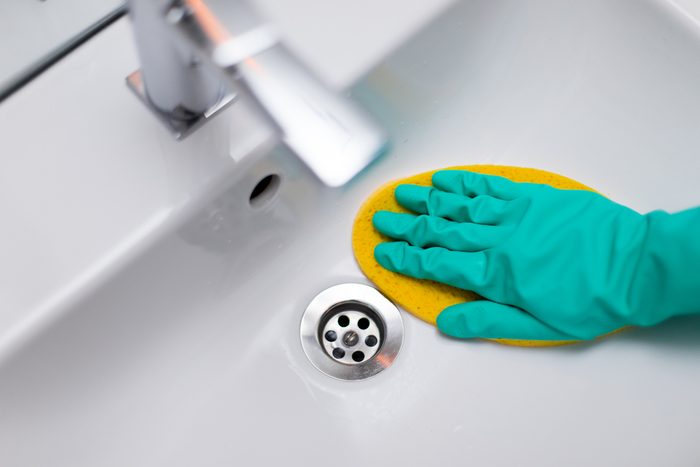 Quinn Martin/Shutterstock
Quinn Martin/Shutterstock
You're using the same sponges for different tasks
Unfortunately, your cleaning tools themselves can become germy and spread bacteria around the house and make you sick. "I recommend having a kitchen-surface cleaning sponge, and a separate bathroom sponge," Maker says. "A great way to do this is to use color-coded sponges—you can pick up a different color for the kitchen and a different color for the bathroom, and then that way you always know what sponge to use where." Be sure to clean these 15 everyday items that are dirtier than a toilet seat.
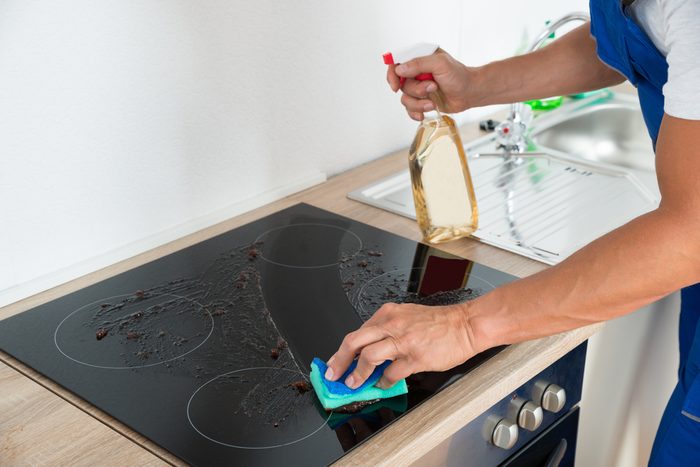 Andrey_Popov/Shutterstock
Andrey_Popov/Shutterstock
You're cleaning the dirty stuff first
Another way to prevent cross-contamination of bacteria is to make sure you're following the proper order of cleaning. "You want to clean the cleanest stuff first and the dirtiest stuff last," Maker says. "If you're cleaning a bathroom counter or the front of cupboards, you're likely not going to have any freakish bacteria existing in those areas." You wouldn't want to start with cleaning a sink (a surprisingly dirty place in your home) or a toilet, she says, and then take that cleaning rag or sponge and use it somewhere else. "You always want to use your tools in the cleanest parts of the house first and then move to the dirtiest parts of the house—and then, of course, there is the option of using paper towels for areas that would make you uncomfortable using a [reusable] cloth."
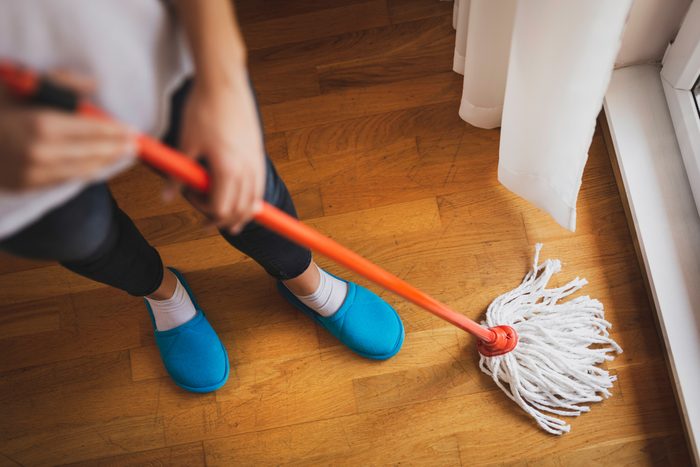 Impact Photography/Shutterstock
Impact Photography/Shutterstock
You're just moving dirt around
Maker also advises cleaning in a zigzag or "S" shape instead of a circle to avoid simply spreading bacteria around a surface. "When you clean in a circular pattern, you're just taking all that dirt and putting it right back where it came from," Maker says. "With the 'S' pattern, spray the surface, start at the top left-hand corner and sweep your way all the way to the top right. Loop or zigzag back and work your way down from top to bottom." This way, she says, you're not redepositing anything anywhere, but instead, you're sweeping the dirt downward toward you. Here's how to clean your kitchen in basically five minutes.
 Andrey_Popov/Shutterstock
Andrey_Popov/Shutterstock
You're not letting products sit
Another reason germs get left behind is that you're not letting your cleaning product soak in long enough to work its magic. Maker calls this "dwell time—it's an opportunity for the product to sit and break down whatever dirt, grease, bacteria, and grime that it's meant to clean," she says. "The problem is when people clean, they often just apply the product and wipe immediately, and that's the wrong way to do it." To save yourself time while making sure your product is truly cleaning up all sickness-causing germs, spray the dirtiest surfaces first and allow them to sit while you clean the less dirty areas first; then, go back and wipe down after the product has sat for a bit. Find out the times you shouldn't use antibacterial wipes to clean.
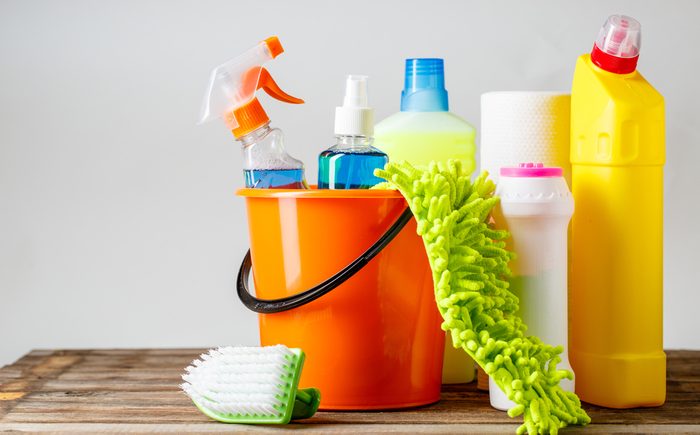 Sergey Mironov/Shutterstock
Sergey Mironov/Shutterstock
You think you're using "green cleaners"
Geller says to beware of "greenwashed" products that don't list their ingredients. "'Natural' products aren't necessarily any healthier than conventional cleaners," she says. In her research, Steinerman has found the same thing: "I have tested a wide variety of fragranced cleaning products, including ones with claims and certifications of being 'green,' 'organic,' 'all-natural,' and 'made with essential oils,'" she says. "All of these fragranced cleaning products emitted potentially hazardous air pollutants. Moreover, the green fragranced products were not significantly different from the regular fragranced products in their emissions of hazardous air pollutants." Unfortunately, there's a lack of transparency from manufacturers in terms of their ingredients. EWG gives better options in its guide to healthy cleaning.
 New Africa/Shutterstock
New Africa/Shutterstock
You don't clean the natural way
But perhaps the safest way to clean is to avoid cleaning products altogether. Steinemann advises using "vinegar, baking soda, hot water, a cut lemon or a cut orange, airing things out, sunshine, and ventilation." Maker says that plain soap and water is enough for most jobs. In addition, there are some products you don't need to use, ever. "Avoid conventional drain cleaners—ingredients in them can be caustic—and use a drain snake instead," Geller says. In addition, "furniture polishes can leave sticky residues which attract dirt and dust," she says. "Use your own DIY polish using olive oil and lemon juice." Just make sure you know the 11 things you should never clean with baking soda.
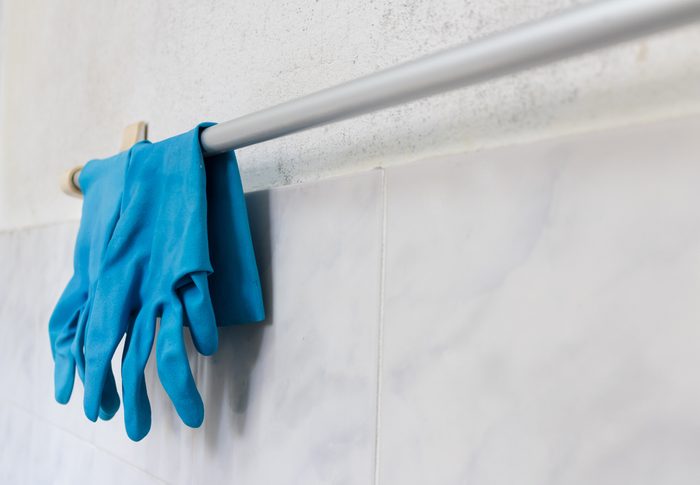 Sarawut Chainawarat/Shutterstock
Sarawut Chainawarat/Shutterstock
You're not wearing protective gear
Definitely wear a mask, gloves, and even goggles when cleaning—depending on what task you're doing. "Gloves can be very helpful to protect the skin, and goggles may be imperative to protect the eyes when working with chemicals," Dr. Caudle says. When dusting, Geller says, "wear a face mask or respirator labeled N95 or P100; they're available at most hardware stores and they filter 95 to 100 percent of particulates." For general cleaning, Maker says she doesn't usually use protective gear, but it's perfect for more intense jobs like those you might do for spring cleaning. "If you're cleaning out a crawl space, or an attic, or something that's super dusty it makes sense to wear protective gear," she says. Plus, "use gloves if you're using really hot water and you want to protect your hands; if you're changing a vacuum filter and you have dust allergies, wearing a mask is a great idea."
 Diego Cervo/Shutterstock
Diego Cervo/Shutterstock
You don't follow the instructions
Cleaning might seem obvious, but you really should read the product instructions so you know you're not putting yourself in harm's way. "Always follow proper dosing and dilution instructions as recommended by the manufacturer," Geller says. Using more won't necessarily get you better results; in fact, "it leaves behind residues and exposes you and your family to a higher concentration of chemicals in the home," says Geller.
"It is important to read the warning labels on products to know the safe way to use them, and also for first aid instructions if exposure occurs," Fleming says. Maker notes that the product instructions will also let you know the amount of "dwell time" it needs to actually get rid of germs. Here's how professional housecleaners clean their homes.
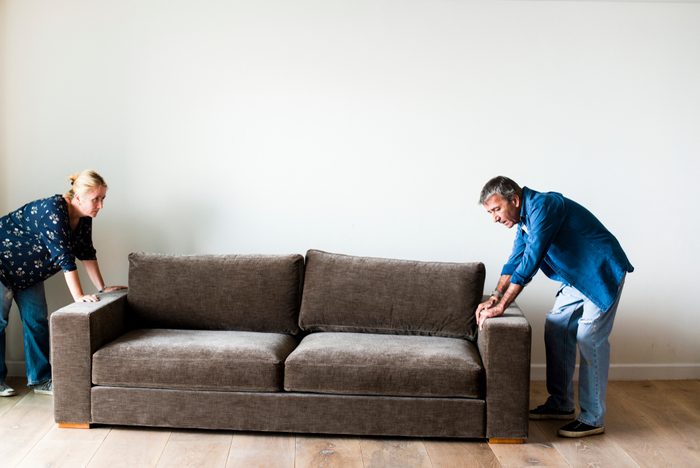 Rawpixel.com/Shutterstock
Rawpixel.com/Shutterstock
You're risking a strain
Cleaning is a physical task, and if you're not careful, or if you overdo it during a spring cleaning spree, it can have physical consequences. "Injuries can happen when cleaning and doing work around the house," Dr. Caudle says. "Lifting items that are too heavy, or lifting improperly, can cause back pain; falls may happen when climbing ladders or step-stools while cleaning; muscle strains or sprains can happen with excessive or strenuous cleaning; plus, carpal tunnel can occur or be exacerbated with repetitive motions." Don't take unnecessary risks, ask for help if you need it, and take breaks so you don't get worn out.
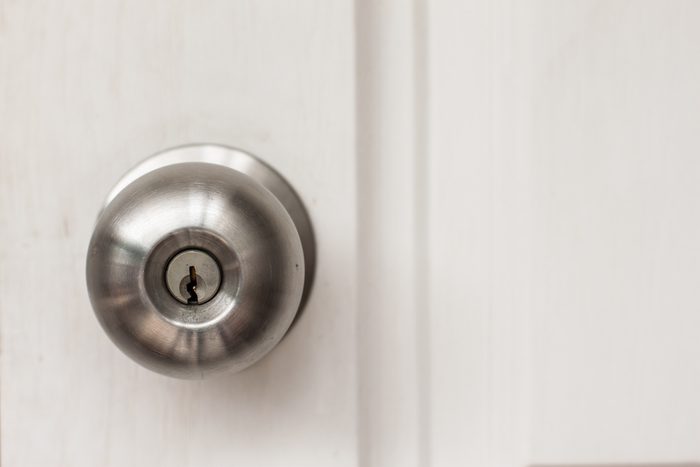 wittaya loysoungsin/Shutterstock
wittaya loysoungsin/Shutterstock
You miss points of contact
With spring cleaning, you might be focused on big jobs that don't get done that often. Just don't overlook the germy places hiding in plain sight. "I call 'points of contact' anything that people touch frequently: Doorknobs, light switch plates, drawer pulls, or any handle. Basically, anywhere hands are going to go and where you could cough and then touch," Maker says. "If someone comes over who's got a cold and he's touching things and then you touch those things, you'll get sick."
Every product is independently selected by our editors. If you buy something through our links, we may earn an affiliate commission.
Originally Published: March 05, 2019
Sign up for articles sent right to your inbox
Enjoy the best stories, advice & jokes delivered right to your inbox!

Subscribe & SAVE Save Up To 84%!
How To Clean Baby's Nose When Sick
Source: https://www.rd.com/list/spring-cleaning-mistakes-make-you-sick/
Posted by: hartidowed.blogspot.com

0 Response to "How To Clean Baby's Nose When Sick"
Post a Comment